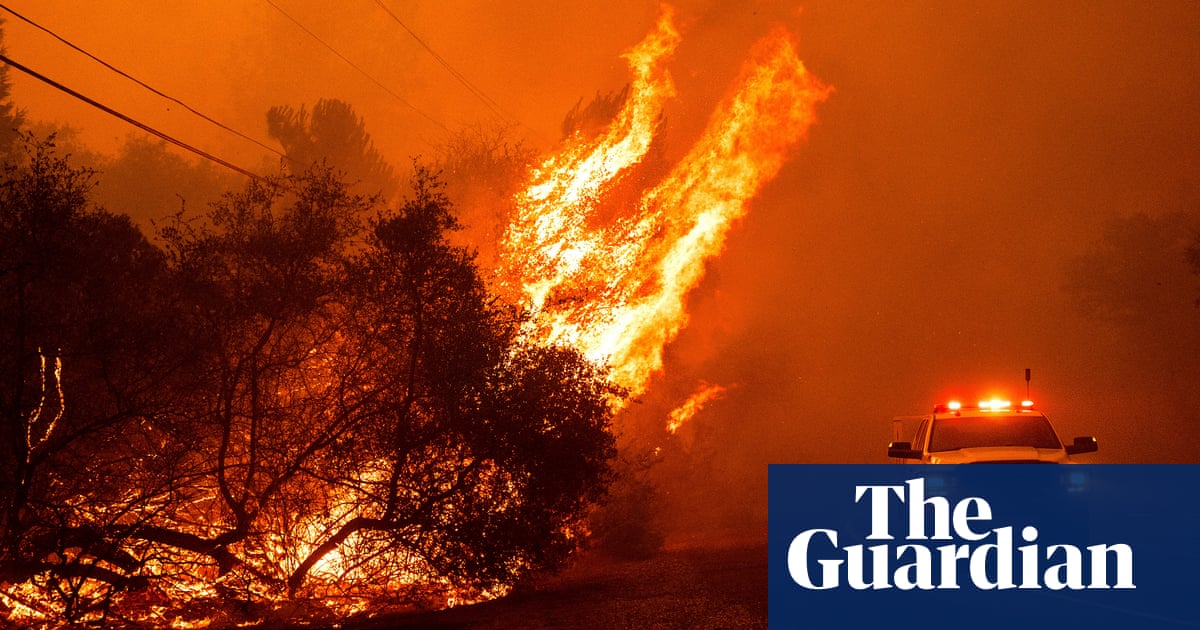Thousands of homes are under threat from a raging wildfire that erupted in northern California on Tuesday, as the state simmers in a brutal and potentially historic heatwave.
Roughly 28,000 residents have been forced to evacuate as the Thompson fire quickly swept across more than 3,500 acres (1,416 hectares) near the city of Oroville, about an hour outside Sacramento, California’s capital.
More than 1,400 fire personnel from across the state have deployed to battle the blaze, which was at 0% containment Wednesday afternoon. Eight injuries have been confirmed by officials, at least half of whom were firefighters, as dangerously high temperatures continue to threaten their health and safety.
“The combination of events has presented a huge challenge for firefighters,” he said, urging the public to take extra precautions to limit new fire starts that can quickly spread crews thin, especially as temperatures spike.
“It’s a tough thing to do,” he said. “You are asking people to hike up a mountain when it’s 108F (42.2C) outside.”
Temperatures in the state capital, Sacramento, were forecasted to reach between 105F and 115F (40.5C and 46.1C) – conditions that could last until Sunday.
“This is going to be a severe, prolonged, potentially record-breaking heatwave that may have large impacts for much of California,” said climate scientist Dr Daniel Swain during a broadcast discussion of the heat event on Monday. The long duration will only add to the potential impacts and intensity, especially because little relief can be expected even after the sun sets. “It just isn’t going to cool off – even at night,” Swain said.
Have we tried beavers yet?
They clear out dead trees and cut them down before they can burn.
Then soak that shit in water by building a dam, which causes water to retain in the ground that also helps prevent fires from spreading.
Even if it doesn’t work (it should work) we deployed the beavers by parachute last time. And that’s be pretty cool to see.
What water are they going to use? NorCal is dry as a bone in the summer, and we won’t see rain or snow until late October (if we’re lucky).
Apparently this place, where they released them less than a year ago for the first time in 75 years
https://www.sfgate.com/bayarea/article/california-beavers-released-in-wild-18569060.php
No, I’m not saying that the beaver reintroduction isn’t going well; I live in an area in the NorCal mountains where I have 3 beaver dams within a mile of my house.
I’m just saying that beavers aren’t really a good way to mitigate wildfire danger because they only help in areas that have year-round water flow, which is a tiny portion of the Northern California forests. As close as I am to beavers, I still can’t get wildfire coverage in my neighborhood, because the beavers only make an impact within about 15 yards of the river, and there just aren’t that many year-round rivers in NorCal (at least relative to the amount of forest land)
Technically, they help where there isn’t year round flow by daming it and keeping it there longer…
Like, this is a real thing with real studies.
Surface level might only look like a small area, but that water seeps into the ground for much further.
Which helps vegation, and that causes more water to be retained, being back new creeks and rivers that more beavers than dam.
Like bro, the first beavers in 75 years were released last year in NorCal…
Give em a minute
Like bro, the first beavers in 75 years were released last year in NorCal…
I think you misunderstood the headline. Beavers are not extinct in CA other than the one place in your article. I’m well aware of the impact of beavers on reintroducing and rehabilitating wetlands. I live on one of the rivers where beavers were reintroduced in the 1940’s. I literally work with ecologists and hydrologists that work on some of these projects.
But guess what? That same river basin that has had beavers damming it for more than 75 years and has had a ton of work from the forestry service, CCC, and beavers had a massive wildfire two years ago. Reintroducing beavers is not enough to stop wildfires in California. There’s literally not enough water and streams compared to the area of forest.
edit: but cool, just downvote and move on when shown to be wrong. Leave this to the people that have some knowledge of the issue
Have we tried beavers yet?
No offense and style points for the funny, but this is a “rake the forests” level comment.
This is the best summary I could come up with:
Roughly 28,000 residents have been forced to evacuate as the Thompson fire quickly swept across more than 3,500 acres (1,416 hectares) near the city of Oroville, about an hour outside Sacramento, California’s capital.
Ed Fletcher, a public information officer with CalFire said the agency goes to great lengths to ensure firefighters have relief and rest but the already challenging work is only made harder in extreme conditions.
“The combination of events has presented a huge challenge for firefighters,” he said, urging the public to take extra precautions to limit new fire starts that can quickly spread crews thin, especially as temperatures spike.
The California governor, Gavin Newsom, declared a state of emergency on Wednesday to ensure resources are readily available to support response and recovery to the fire.
“This is going to be a severe, prolonged, potentially record-breaking heatwave that may have large impacts for much of California,” said climate scientist Dr Daniel Swain during a broadcast discussion of the heat event on Monday.
The dangerous weather conditions this week will pose health risks to large swaths of the population, forecasters cautioned, in particular to people unable to access cooling.
The original article contains 755 words, the summary contains 190 words. Saved 75%. I’m a bot and I’m open source!



